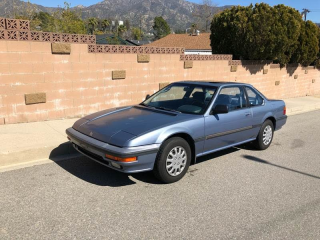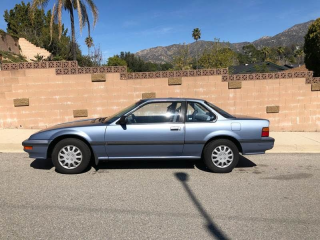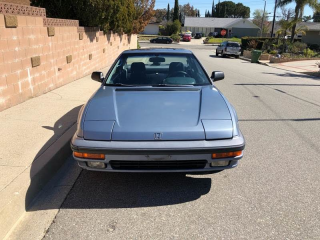The 1989 Honda Prelude, part of the third generation (1988-1991), is a front-wheel-drive sport compact coupe known for its sharp, aerodynamic styling and engaging driving dynamics. Key trims included the S and Si. When new, pricing ranged from around $14,000 to $19,000. Its pop-up headlights, refined interior, and sporty handling made it a standout and popular choice for enthusiasts seeking a stylish and fun-to-drive coupe.
The Good
The 1989 Prelude offers a blend of sharp design, responsive handling, and Honda's legendary reliability. Its sporty nature appeals to driving enthusiasts, while its comfortable interior and fuel efficiency make it a practical and enjoyable daily driver. It represents excellent value.
The Bad
Common weaknesses for the 1989 Honda Prelude include potential for rust, especially around wheel wells and rocker panels. Transmission issues, particularly with automatics, and aging suspension components are also concerns. Electrical gremlins can sometimes surface with age.
1989 Honda Prelude: Quick Overview
- Engine Options: The 1989 Honda Prelude was primarily offered with two engine options:
- 2.0L 16-Valve SOHC 4-Cylinder Engine (B20A3): Standard on the S trim.
- 2.0L 16-Valve DOHC 4-Cylinder Engine (B20A5): Found in the Si trim, offering a performance boost.
- 2.0L 16-Valve SOHC 4-Cylinder Engine (B20A3): Standard on the S trim.
- Horsepower:
- S Trim: Approximately 108 horsepower.
- Si Trim: Approximately 135 horsepower.
- S Trim: Approximately 108 horsepower.
- Fuel Economy:
- EPA estimates for manual transmission models were around 22 MPG city / 28 MPG highway. Automatic transmission versions were slightly lower.
- EPA estimates for manual transmission models were around 22 MPG city / 28 MPG highway. Automatic transmission versions were slightly lower.
- 0-60 Times:
- Si models with manual transmission could achieve 0-60 MPH in roughly 8.5 to 9 seconds, while S models were closer to 10-11 seconds.
- Si models with manual transmission could achieve 0-60 MPH in roughly 8.5 to 9 seconds, while S models were closer to 10-11 seconds.
- Towing Capacity:
- Towing capacity is not a typical feature or consideration for the Honda Prelude, as it was designed as a personal sport coupe, not a utility vehicle.
- Towing capacity is not a typical feature or consideration for the Honda Prelude, as it was designed as a personal sport coupe, not a utility vehicle.
- Trim-Level Features:
- S Trim: Typically included power windows, power door locks, cruise control, a tilt steering wheel, and a basic sound system. Often came with a 5-speed manual or optional 4-speed automatic transmission.
- Si Trim: Featured the more potent DOHC engine, alloy wheels, a sport-tuned suspension, fog lights, a sunroof (often standard), upgraded interior trim, and sometimes anti-lock brakes (ABS) as an option. The Si was the performance-oriented model.
- S Trim: Typically included power windows, power door locks, cruise control, a tilt steering wheel, and a basic sound system. Often came with a 5-speed manual or optional 4-speed automatic transmission.
1989 Honda Prelude Specifications
Vehicle Information
| Year | 1989 |
| Make | Honda |
| Model | Prelude |
| Trim | - |
| Style | - |
| Type | Coupe |
| Category | Compact Car |
Manufacturing Details
| Made In | Japan |
| Manufacturing City | SAITAMA/SAYAMA |
Dimensions
| Doors | 2-Door |
| Curb Weight | - |
| Gross Vehicle Weight Rating | - |
| Overall Height | 51.00 inches |
| Overall Length | 175.60 inches |
| Overall Width | 67.30 inches |
| Wheelbase Length | 101.00 inches |
| Standard Seating | 5 |
Engine & Performance
| Engine | 2.0-L L-4 DOHC 16V |
| Engine Size | 2L |
| Engine Cylinders | 4 |
| Transmission | 4-Speed Automatic |
| Transmission Type | Automatic |
| Transmission Speeds | 4-Speed |
| Drivetrain | Front-Wheel Drive |
Additional Features
| Anti-Brake System | Non-ABS |
| Steering Type | Rack & Pinion |
Pricing
| Manufacturer Suggested Retail Price (MSRP) | $13,945 |
| Invoice Price | - |
| Delivery Charges | - |
Vehicle History Report
Vehicle
Specifications
Specifications
Ownership
History
History
All History
Events
Events
NMVTIS Title
History Check
History Check
Salvage/Rebuilt
Check
Check
Accident
Check
Check
Theft
Check
Check
Open Lien
Check
Check
Past Sale
Listings
Listings
Safety
Recalls
Recalls
Odometer
Check
Check
Market Price
Analysis
Analysis
What Problems Does the 1989 Honda Prelude Have?
The 1989 Honda Prelude, while generally reliable for its era, does have some commonly reported issues that owners should be aware of. One of the most prevalent concerns is related to the automatic transmission. Many owners have experienced premature failure or slipping in automatic gearboxes, particularly as the vehicles age. This can manifest as delayed shifting, harsh engagement, or complete transmission failure, often requiring costly repairs or replacement.
Another significant area to watch for is rust. Like many cars from this period, the 1989 Prelude is susceptible to corrosion, especially in areas with harsh winters or high humidity. Key areas to inspect include the rocker panels, wheel wells, rear quarter panels, and the undercarriage. Extensive rust can compromise structural integrity and lead to expensive bodywork.
Engine issues can also arise. While the Honda engines are robust, some owners report issues with the head gasket, particularly on higher-mileage examples. Blown head gaskets can lead to overheating, coolant leaks, and white smoke from the exhaust. Additionally, the timing belt needs regular replacement according to manufacturer recommendations; neglecting this can lead to catastrophic engine damage. For the 1989 model year, there aren't widespread, model-year-specific major recalls that stand out as particularly problematic for this generation. However, general maintenance items like aging suspension components (shocks, struts, bushings) can wear out, leading to a less comfortable ride and potential handling issues. Electrical issues, such as malfunctioning power windows, door locks, or sensors, can also occur due to the age of the wiring harness.
Long-term reliability hinges heavily on consistent maintenance. Cars that have been well-maintained with regular fluid changes, timely belt replacements, and prompt attention to any emerging problems tend to fare much better than those that have been neglected.
Another significant area to watch for is rust. Like many cars from this period, the 1989 Prelude is susceptible to corrosion, especially in areas with harsh winters or high humidity. Key areas to inspect include the rocker panels, wheel wells, rear quarter panels, and the undercarriage. Extensive rust can compromise structural integrity and lead to expensive bodywork.
Engine issues can also arise. While the Honda engines are robust, some owners report issues with the head gasket, particularly on higher-mileage examples. Blown head gaskets can lead to overheating, coolant leaks, and white smoke from the exhaust. Additionally, the timing belt needs regular replacement according to manufacturer recommendations; neglecting this can lead to catastrophic engine damage. For the 1989 model year, there aren't widespread, model-year-specific major recalls that stand out as particularly problematic for this generation. However, general maintenance items like aging suspension components (shocks, struts, bushings) can wear out, leading to a less comfortable ride and potential handling issues. Electrical issues, such as malfunctioning power windows, door locks, or sensors, can also occur due to the age of the wiring harness.
Long-term reliability hinges heavily on consistent maintenance. Cars that have been well-maintained with regular fluid changes, timely belt replacements, and prompt attention to any emerging problems tend to fare much better than those that have been neglected.
How long will the 1989 Honda Prelude last?
Based on owner data and typical maintenance, a well-maintained 1989 Honda Prelude can realistically achieve average mileages of 200,000 to 250,000 miles, and sometimes even exceed 300,000 miles. This demonstrates Honda's inherent long-term durability. However, this longevity is directly tied to consistent maintenance, particularly addressing common issues like timely timing belt changes, proper transmission fluid service, and rust prevention. Over time, weaknesses like automatic transmission reliability and susceptibility to rust become more pronounced if not proactively managed. Despite these potential challenges, the core engine and chassis are known for their robustness, allowing many Preludes to remain on the road for decades with dedicated care.
What Technology & Safety Features are Included?
The 1989 Honda Prelude offered a blend of then-modern technology and essential safety features for its time. In terms of built-in tech, it was quite advanced for a 1980s coupe. Standard features often included power windows and power door locks, which were becoming more common but still a desirable convenience. Cruise control was also frequently standard, enhancing comfort on longer drives. The entertainment system typically consisted of an AM/FM stereo radio with a cassette player, sometimes with multiple speakers for improved audio quality. Many Preludes also featured a tilt steering wheel, allowing drivers to adjust the steering column for a more comfortable driving position.
Driver-assistance features were minimal by today's standards, but it did offer four-wheel disc brakes on some models, particularly the Si trim, which provided superior stopping power compared to drum brakes. Anti-lock braking systems (ABS) were available as an option on higher trims, representing a significant safety advancement at the time, helping prevent wheel lock-up during hard braking.
Safety features were also prioritized. Standard safety equipment included three-point seatbelts in the front and lap belts in the rear. The car's structure was designed with crumple zones to absorb impact energy. Pop-up headlights, while a styling element, also served a practical purpose by retracting to maintain a clean aerodynamic profile when not in use.
Crash-test ratings for vehicles from this era are not as comprehensively documented or standardized as they are today. However, the Honda Prelude of this generation was generally considered a safe vehicle for its class, with Honda's reputation for solid engineering contributing to its safety perception. The optional ABS would have provided a distinct advantage in emergency braking situations. Advanced features like navigation systems or sophisticated infotainment were not available; the focus was on core functionality and driver engagement.
Driver-assistance features were minimal by today's standards, but it did offer four-wheel disc brakes on some models, particularly the Si trim, which provided superior stopping power compared to drum brakes. Anti-lock braking systems (ABS) were available as an option on higher trims, representing a significant safety advancement at the time, helping prevent wheel lock-up during hard braking.
Safety features were also prioritized. Standard safety equipment included three-point seatbelts in the front and lap belts in the rear. The car's structure was designed with crumple zones to absorb impact energy. Pop-up headlights, while a styling element, also served a practical purpose by retracting to maintain a clean aerodynamic profile when not in use.
Crash-test ratings for vehicles from this era are not as comprehensively documented or standardized as they are today. However, the Honda Prelude of this generation was generally considered a safe vehicle for its class, with Honda's reputation for solid engineering contributing to its safety perception. The optional ABS would have provided a distinct advantage in emergency braking situations. Advanced features like navigation systems or sophisticated infotainment were not available; the focus was on core functionality and driver engagement.
What Colors Options are Available?
1989 Honda Prelude Prices and Market Value
When new, the 1989 Honda Prelude ranged from approximately $14,000 for the base S model to around $19,000 for the sportier Si trim. Like most vehicles, the Prelude experienced significant depreciation in its early years. However, as a classic sport coupe with Honda's reputation for reliability, the 1989 Prelude has seen a stabilization and even an increase in value for well-maintained examples, especially the Si trim. Current used market prices vary greatly, typically ranging from $2,000 to $7,000 for drivers in fair to good condition. Pristine, low-mileage examples, particularly Si models with desirable options, can command higher prices, sometimes exceeding $10,000. Factors affecting resale value include overall condition, mileage, maintenance history, rust prevalence, and the presence of original documentation or modifications.
1989 Honda Prelude Cost of Ownership
The 1989 Honda Prelude is generally considered economical to own. Insurance costs are typically low due to its age and class. Fuel economy is decent, especially with the manual transmission, making it relatively inexpensive to run. Maintenance costs are moderate; routine items are affordable, but the availability of parts for certain components may require specialized sourcing. Repair costs can be a factor, particularly for transmission issues or rust repair, which can become significant expenses. However, for a well-maintained example, overall long-term ownership costs are manageable, making it an economical choice for enthusiasts and daily drivers alike, provided major repairs are avoided through diligent upkeep.
1989 Honda Prelude Fuel Efficiency
Fuel Type
Gasoline
Fuel Capacity
15.90 gallons
City Mileage
23 miles/gallon
Highway Mileage
28 miles/gallon
1989 Honda Prelude Warranty
Basic
Original warranty
0 months / No data
Estimated remaining
Expired
Powertrain
Original warranty
0 months / No data
Estimated remaining
Expired
Rust
Original warranty
0 months / No data
Estimated remaining
Expired
1989 Honda Prelude Insurance
Insurance for a 1989 Honda Prelude is moderately priced, reflecting its status as a Coupe with strong safety ratings and
reasonable repair costs.
reasonable repair costs.
How Does the 1989 Honda Prelude Compare to Other Coupe?
The 1989 Honda Prelude competed in a segment filled with sporty coupes and sedans. Key rivals included the Toyota Celica, Nissan 240SX, and the Ford Probe. In terms of performance, the Prelude Si, with its DOHC engine and refined handling, was a strong contender, offering a more sophisticated driving experience than some rivals. The Toyota Celica offered similar sporty dynamics, often with a slightly more aggressive aesthetic. The Nissan 240SX was known for its rear-wheel-drive layout and tuner-friendly nature, appealing to a different type of enthusiast.
Features-wise, the Prelude was often at the forefront with its aerodynamic design, pop-up headlights, and optional ABS. It generally offered a more premium interior feel compared to some of its competitors, with better materials and ergonomics. The Celica also offered a good feature set, while the 240SX was more spartan but offered a blank canvas for customization.
Regarding reliability, Honda's reputation often gave the Prelude an edge. While not immune to issues, they were generally perceived as more dependable long-term than some domestic rivals like the Probe, which had a more mixed track record. Toyota also boasted excellent reliability with the Celica.
In terms of price, the Prelude was often priced slightly higher than some competitors when new, reflecting its premium positioning. Currently, used prices are competitive, with good examples of all these cars holding their value reasonably well.
Alternatives to consider include the aforementioned Toyota Celica (especially the GT-S models), the Mitsubishi Eclipse (offering strong performance and styling), or even the Acura Integra (which shared some mechanicals and offered a sportier feel). For those prioritizing pure RWD fun and customization, the Nissan 240SX is a strong alternative. However, for a balanced package of performance, comfort, reliability, and style, the 1989 Honda Prelude remains a compelling choice, often outperforming rivals in overall refinement and daily drivability.
Features-wise, the Prelude was often at the forefront with its aerodynamic design, pop-up headlights, and optional ABS. It generally offered a more premium interior feel compared to some of its competitors, with better materials and ergonomics. The Celica also offered a good feature set, while the 240SX was more spartan but offered a blank canvas for customization.
Regarding reliability, Honda's reputation often gave the Prelude an edge. While not immune to issues, they were generally perceived as more dependable long-term than some domestic rivals like the Probe, which had a more mixed track record. Toyota also boasted excellent reliability with the Celica.
In terms of price, the Prelude was often priced slightly higher than some competitors when new, reflecting its premium positioning. Currently, used prices are competitive, with good examples of all these cars holding their value reasonably well.
Alternatives to consider include the aforementioned Toyota Celica (especially the GT-S models), the Mitsubishi Eclipse (offering strong performance and styling), or even the Acura Integra (which shared some mechanicals and offered a sportier feel). For those prioritizing pure RWD fun and customization, the Nissan 240SX is a strong alternative. However, for a balanced package of performance, comfort, reliability, and style, the 1989 Honda Prelude remains a compelling choice, often outperforming rivals in overall refinement and daily drivability.
Final Verdict: Is the 1989 Honda Prelude a Good Coupe?
The 1989 Honda Prelude is ideal for enthusiasts and practical buyers seeking a stylish, fun-to-drive coupe with legendary Honda reliability and reasonable running costs. It's worth buying, especially in Si trim, for those who appreciate classic Japanese automotive design and engaging handling. It's best purchased used, as new ones are obviously unavailable. When buying, prioritize examples with comprehensive maintenance records, minimal rust, and ideally, a manual transmission for the best driving experience and fewer potential transmission woes. Thorough inspection of the engine and transmission is crucial. For the right price and condition, the 1989 Prelude offers excellent value and a rewarding ownership experience for those willing to keep it maintained.



